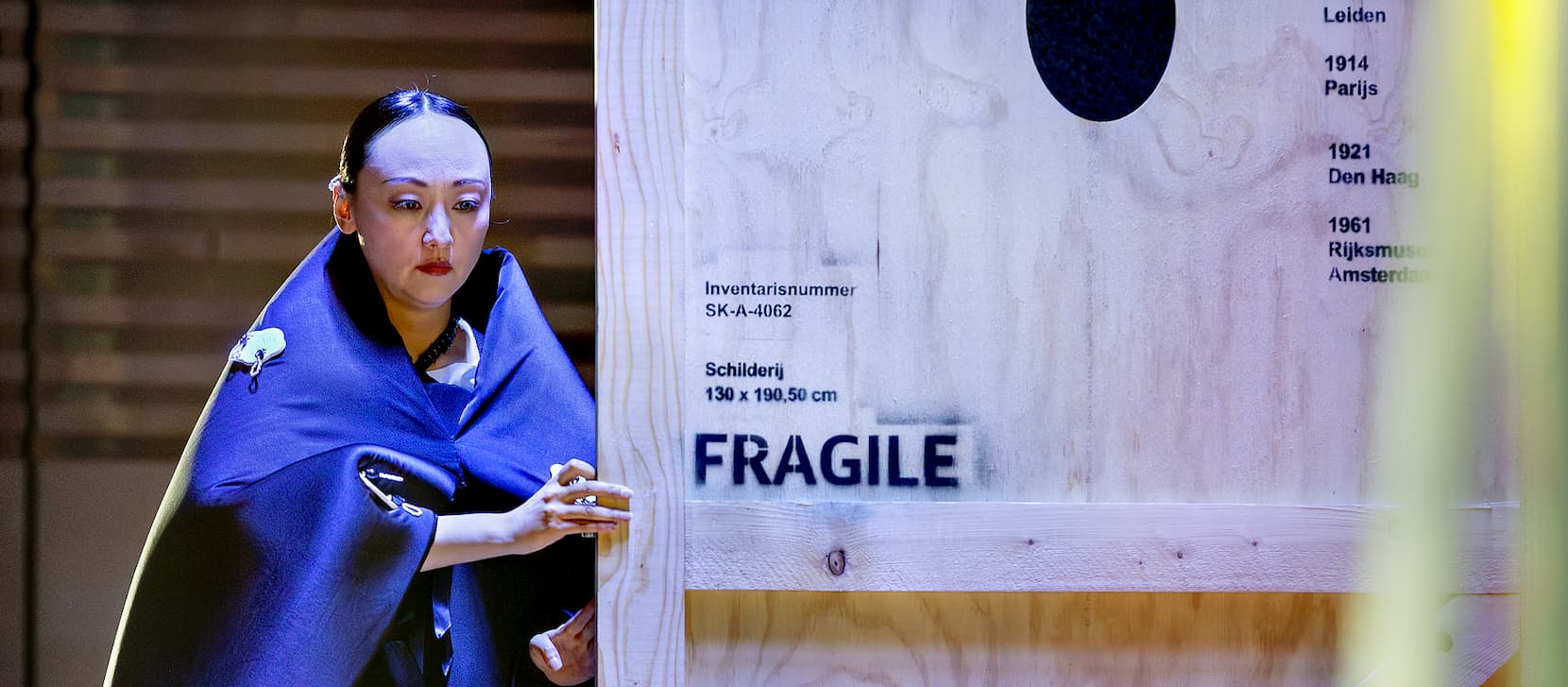
Copyright information:© DigiDaan
Otemba – Daring Women is a musical theatre piece in celebration of Amsterdam 750, composed by Misato Mochizuki. The piece is based on the painting Portrait of Pieter Cnoll, Cornelia van Nijenrode, their two daughters Catharina and Hester, the enslaved Surapati and an enslaved woman (Batavia, 1665) by Jacob Coeman, which is in the Rijksmuseum. In Otemba – Daring Women, Cornelia steps out of the painting and has a conversation with the restorer about colonial relations, the feminine gaze and autonomy.
click here to read the interview with Janine Brogt en Jan van den Berg
The restoration of the 17th-century painting that depicts a colonial scene results in a nocturnal encounter between the Indonesian restorer and the woman in the portrait: the Japanese-Dutch Cornelia van Nijenrode, wife of Pieter Cnoll, a wealthy senior merchant in Batavia. She remarried after his death and was the first woman in the Netherlands to file a lawsuit around financial self-determination when she wished to divorce her second husband.
The libretto of Otemba – Daring Women is by Janine Brogt, and the piece is directed by Jan van den Berg. The leading roles are played by soloists Ryoko Aoki, Bernadeta Astari and Michael Wilmering. Misato Mochizuki was previously featured at the Holland Festival with L’heure bleue in 2013.
'Otemba' is not just the title of the piece, but also one of over one hundred and sixty words that Japanese derives from the Dutch language. It refers to rebellious women who refuse to be subjected and go their own way.
'In Otemba, different characters from different times come together and champion a new view of our history. Restoration is also called ‘management of change’, and this restoration offers a renewed, decolonising perspective on the past. Otemba comes to life.'
– Jan van den Berg
dates
Thu June 19 2025 8:30 PM
Fri June 20 2025 8:30 PM
Sat June 21 2025 8:30 PM
prices
- default including drink from € 33,75
- CJP/student/scholar incl. a drink € 17,75
information
-
English, Indonesian, Japanese surtitles: English, Dutch
-
1 hour 20 minutes
Are you curious about the story behind this remarkable opera? Visit the introduction by librettist Janine Brogt at 7:45 PM (language: Dutch).
SYNOPSIS
During the restoration of a 17th-century painting at the Rijksmuseum in Amsterdam, an extraordinary event unfolds: Cornelia van Nijenrode, a Japanese-Dutch woman from the colonial past, steps out of her frame — and her own time — into the 21st century. She engages Kirana Diah, the Indonesian restorer of the painting, in a nocturnal conversation about colonial power structures, the female gaze, and the quest for autonomy.
The performance depicts a magical moment in the restoration process: a one-time nocturnal encounter of heterogeneous identities and cultures, cutting across the constraints of time and space; suspended between painting and reality, between then and now, between East and West.
Alongside them: a scanning robot, an artificial intelligence programmed for neutral data analysis yet surprisingly, it too finds its own voice. Inspired by Portrait of Pieter Cnoll, Cornelia van Nijenrode, their two daughters Catharina and Hester, the enslaved Surapati, and an enslaved woman (Batavia, 1665) by Jacob Coeman (Rijksmuseum Amsterdam).
CONTEXT
Cornelia van Nijenrode was a 17th-century woman of mixed Japanese and Dutch heritage, part of the upper class of former Batavia. As a child, she was cast out of Japan because of her mixed background; as an adult, she was vilified for initiating divorce proceedings against her second husband, Joan Bitter, in which she asserted her right to financial self-determination.
Kirana Diah is a young art historian from present-day Jakarta who has left her home country to work as a restorer at the Rijksmuseum in Amsterdam. She specializes in restoring paintings originating from Indonesia, driven by the conviction that the history of a painting must not be erased through restoration. In her view, visible scars on a canvas are powerful witnesses to the pain of the (colonial) past.
Miro is a curator specialising in computational materials science, responsible for the scanning technology that provides information about the pigments used and insight into the painting process and possible underdrawings and alterations of the painting.
In the Amsterdam of 2025, Kirana Diah works as a conservator on the 17th-century painting depicting Cornelia van Nijenrode with her first husband Pieter Cnoll, chief merchant for the VOC in Batavia. Kirana is especially drawn to the painting because of Untung Surapati, one of Indonesia’s first freedom fighters. But Cornelia challenges her to a nocturnal conversation about untamability, about how they each view themselves and the other, about decolonization and self-determination. How do you, across centuries, look at each other’s cultural realities?
Restoring a painting is sometimes described as “management of change.” How we look at our history — how we gather knowledge, create knowledge, and rewrite history — is a political act. And so, too, is the way we restore a painting.















